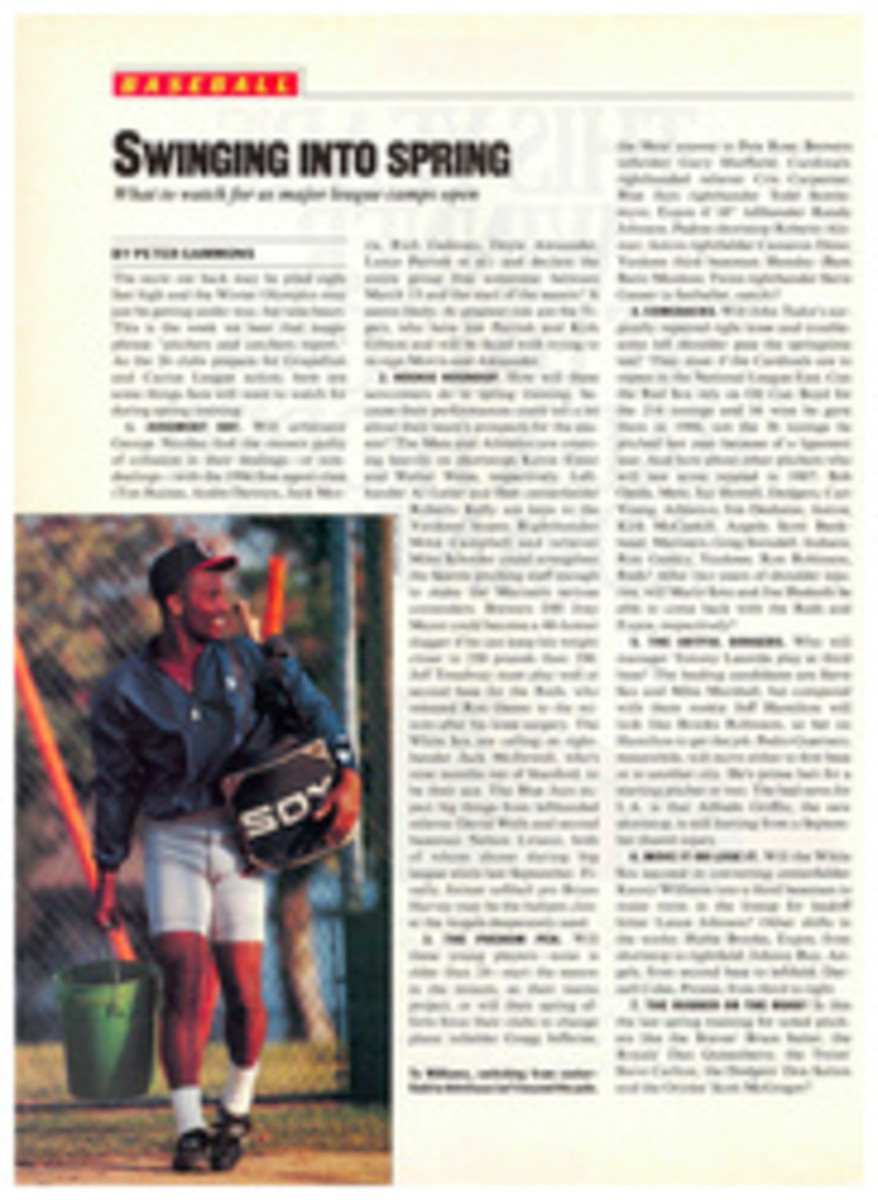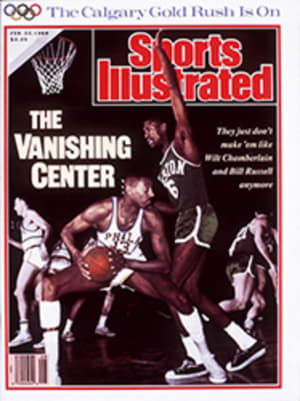
SKIING ON THE EDGE OF DANGER
"If you get caught in an avalanche, the first thing to do is try and 'swim' your way out. If that fails, there are three things I want you to remember." The 13 skiers gathered on the slope at Snowbird ski resort in Utah listened to Ray Santa Maria with such intense concentration you could hear a snowflake drop.
"First, fill your lungs with air when you feel the slide slowing down. That way you'll have some room to breathe when the avalanche sets up around you like wet cement. Second, cover your mouth with one hand so you don't inhale any snow. And third"—Santa Maria bent down and placed a red ski glove on the ground—"try to stick one arm up, whichever way you think up is. Even if just one finger is sticking out of the snow it will make it that much easier to find you."
Santa Maria was watching us intently as his last words sank in. It had been less than two weeks since five people ventured out-of-bounds near Breckenridge, Colo. Four of them had died in an avalanche. There wasn't a skier among us who didn't know that, and yet we had just paid $70 apiece to join Santa Maria and two of his fellow guides on the Interconnect Adventure Tour. In something like six hours we would ski an 18-mile circuit that included the resort areas of Snowbird, Alta, Brighton and Solitude. Much of the time we would be out-of-bounds in the backcountry of the Wasatch-Cache National Forest, where the risk of an avalanche would be substantial. Ski-area managers take great pains to reduce the risk of avalanches. Dynamite blasting and even artillery shells are used to trigger avalanches before skiers are allowed on the slopes. It's a delicate and expensive precaution and one taken sparingly in the vast backcountry areas of national forests.
The Interconnect Adventure Tour, which operates under a special-use permit from the U.S. Forest Service, is one of the few relatively safe ways to ski the backcountry. Santa Maria's lecture was not the first indication of the serious risks ahead. That had come at the start of the day when there was the obligatory signing of a waiver releasing Santa Maria and Ski Utah, Inc., which runs the tour, from any responsibility in case of an accident. Then, even before Santa Maria began outlining the perils we might face, Rod Keller, one of his associates, handed me a small yellow package hanging from a cord loop. "You aren't superstitious, are you?" Keller asked. I looked at the package. Someone had written the number 13 on it.
"This is your beeper," Keller said. "It will help us find you if you get buried or lost. Put the string around your neck and wear this inside your clothes." As if that were not sufficiently chilling, when I held the cigarette-pack-sized device to my ear, I discovered that it was already on. I could faintly hear rapid, high-pitched peeps coming from within. I quickly stuffed it inside my sweater. My heart felt as if it were beating in sync with its little yellow companion.
Safety—ours, primarily, but theirs as well—was paramount in the minds of Santa Maria, Keller and John Gammon, who would be our guides. Each would be easy to spot in his fire-engine-red ski suit. Each carried a walkie-talkie. Not only could they communicate with one another, but also, if necessary, their transmitters were powerful enough to call for outside help. Each guide also carried 40 pounds of equipment—medical supplies, a collapsible shovel and other emergency gear—all efficiently stowed in brightly colored backpacks.
At a casual glance, the ski equipment the guides wore looked identical to my own. Long Alpine skis, quick-release safety bindings and heavy plastic-shell boots. But there was a subtle, and important, difference. The ski poles that the guides carried were specially designed telescoping models that could be extended to a length of 12 feet. If someone became buried under the snow, the poles could be converted into probes to help in the search. I hoped we would have no need to see them in operation.
Once the lecture was over, the rest of our preparations went quickly. We took a tram ride to the top of Snowbird, where Santa Maria and his partners checked each individual's skiing ability—it must be at least advanced-intermediate—on a run back down to the base. After our descent, we went by van to neighboring Alta, where the tour actually started. At 10 a.m. the sun was already high in the clearest sky we had seen in a week. The air and snow were beginning to warm up, which was not necessarily good news: conditions like these increase the danger of avalanches.
It took three successive chair lifts to get us to the 10,000-foot ridgeline at Alta. Between the second and third lifts Santa Maria performed a final beeper check. At the top we ignored the Day-Glo out-of-bounds signs, began traversing Alta's ridgeline, plunged into the backcountry and were immediately surrounded by trees.
We emerged from the forest at the top of a wide-open bowl, and Santa Maria analyzed the terrain. Santa Maria, 34, has spent almost a dozen years helping people to ski. He is a certified emergency medical technician and has been a member of the ski patrol at Park City, Utah, where he also did avalanche-control work and was responsible for evaluating snow conditions.
After a moment of thought, Santa Maria issued his instructions. He would ski down one side of the slope and Gammon would ski the other. Then each of us could pick his own line of descent, provided we stayed within the boundaries defined by our guides' tracks. "O.K., nobody wears their pole straps," Santa Maria reminded us. "If you get into a slide, we don't want you trying to swim while you're wearing them."
With the preliminaries over, Santa Maria pushed off in a white swirl, the powder spraying to either side of him as he linked one turn to another on the way down to the valley floor. Gammon went next. After receiving a radioed all clear, we followed, one at a time, with Keller the last to go.
When all of us had reassembled on the valley floor, Santa Maria took the lead again and we set off once more into the woods. I could see that our route would be taking us around the side of a steep mountain.
After about 20 minutes, Santa Maria called us to a halt. "From here we'll go one at a time." he said. "We'll be skiing across a bunch of avalanche chutes. Keep about 100 feet between you, and when you're in the open just keep going. Stop only after you've gotten back into the trees."
The chutes Santa Maria referred to were a series of swaths, 50 to 200 feet wide, cut through the trees by the force of dozens of avalanches. Now covered by a layer of fresh snow, they appeared perfectly tame. But as I looked up the mountain I could sense the hidden power. The thought of a wall of white stuff speeding down from above kept me moving. It took about 10 minutes to ski across this beautiful obstacle course.
At the far side, Santa Maria was standing at the top of the Dog Lake Chute, a narrow bowl covered with a perfect coat of snow. "I don't know," he said. "We haven't skied this all year. There's a lot of snow up here. More than five feet. I have no idea how stable it is." I could sense his anticipation and his trepidation. It was a beautiful day. This was what we had all been waiting for.
Checking that we had safely made the trees, Santa Maria took a short trip across the top of the chute, intentionally bouncing on his skis as he went. If the snow was really loose it would give way beneath him, and we would have an answer we didn't want. It didn't give, and he returned to the group. Then Gammon traversed the entire chute a little farther down the hill. Still no snow movement.
Santa Maria said, "O.K., we'll ski it. The three weakest skiers"—he pointed to make sure they knew who they were—"you'll ski another route." There was disappointment but no sign of protest on the faces of the three who had been singled out and excluded.
"For the rest of you, just remember, try not to fall," Santa Maria said. "A falling skier could set this off. If you fall, I want you to get right back up and keep going. Don't fool around with your hat. Don't wipe the snow off. Just keep skiing." That's when the real fear began to set in.
As Santa Maria plunged downhill I inched to the edge of the slope to watch, but the hill's pitch was so great that I lost sight of him for the first half of his run. When he came back into view at the bottom I breathed a little easier. But not for long. My turn. I traversed the bowl looking for the right place to start down. As I turned downhill I lost my balance. It happened all too quickly. All I could think of was "Don't fall." Somehow I caught myself. I was carrying more speed than I wanted but was still able to begin carving turns as I raced to the valley floor. Making my final turn around a pine tree whose top was barely peeking through the snow's surface, I pointed my skis straight downhill and seemed to be flying the last few hundred feet. I came to a stop next to Santa Maria. I'm sure the grin on my face was a dead giveaway. I had left my fear up top.
Later in the day we had a chance to see the destruction caused by some recent snowslides. "See that slide over there?" Santa Maria pointed across a valley between us and another mountain. "Those tracks on the left are from another Interconnect tour. We were skiing there a few days ago, and about 15 minutes later some cross-country skiers set a slide off from above. We didn't even hear about it until we got home that night."
He sounded almost cavalier. But I knew that Santa Maria was all business. In 1982 his best friend was killed in an avalanche near Park West resort in Utah, and he himself has been caught in a few "small slides." For several years he has been keeping track on a computer of the tours he guides: weather, areas skied, snow conditions, avalanches sighted. All the data is stored on floppy disks to help him predict the risks. At his home in Park City he also keeps track of wind, temperature and snowfall.
At lunch Santa Maria had talked about the accident in Colorado. "Those skiers in Breckenridge weren't the first people to ski the bowl where they died," he said. "Apparently there were lots of tracks all over the place. It's always better to err on the side of caution. You just never know when the snow is going to let go."
PHOTO
LORI ADAMSKI-PEEK
Santa Maria urges caution but still gets in a few kicks.
PHOTO
LORI ADAMSKI-PEEK
Cutting a sinuous trail, Santa Maria tests the stability of a backcountry snowfield.
Former ski patrolman Daniel P. Wiener is an editor for "U.S. News & World Report."

